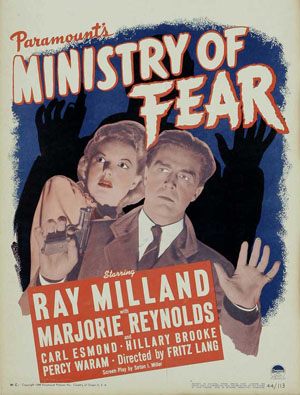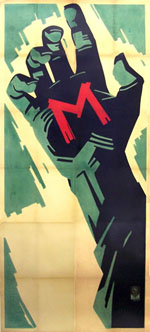“In keeping with my monomaniacal commitment to review every single Fritz Lang film that appears on home video,” writes Dave Kehr, “here‘s an account of Criterion’s very nice new release of Lang’s 1944 quasi-propaganda film, Ministry of Fear. It may fade out into conventionality toward the end…, but the first couple of reels are gangbusters—possibly Lang’s most spectacular return to Weimar stylistics, apart from Secret Beyond the Door.”
Writing for Criterion, Glenn Kenny agrees that Ministry of Fear is the work of “the great cinematic maker of primal nightmarish myth that he had practically begun his career as…, a work that is roundly in the tradition of such magnificently doom-laden paranoid silent thrillers of his as The Spiders (1919), Dr. Mabuse, the Gambler (1922), and Spies (1928). (Not to mention 1921’s Destiny, the film that convinced Hitchcock himself that the art form of the future was being printed on celluloid.)”
The Chicago Reader‘s J.R. Jones: “After the film was released in October 1944, Lang partnered with actress Joan Bennett and producer Walter Wanger to form an independent production company that would create some of Lang’s weirder, more sexually obsessed Hollywood films: (Scarlet Street, The Woman in the Window). Ministry of Fear may suffer by comparison to those movies: set in wartime London, it operates like a conventional action thriller, with Nazi spies and a microfilm hidden in a cake. But [Seton I.] Miller’s script, adapted from a Graham Greene novel, is so perplexing that the severity of Lang’s imagery takes over; the story seems disconnected to the point of delirium.”
Meantime, a new restoration of M (1931) is screening at New York’s Film Forum through March 28. Jonathan Rosenbaum in 1997: “Shot in only six weeks, it’s the best of all serial-killer movies — a dubious thriller subgenre after Lang and three of his disciples, Jacques Tourneur (The Leopard Man, 1943), Alfred Hitchcock (Psycho, 1960), and Michael Powell (Peeping Tom, 1960), abandoned it. M is also a masterpiece structured with the kind of perfection that calls to mind both poetry and architecture and that makes even his disciples’ classics seem minor by comparison.”
“Who actually was the Murderer Among Us—as Fritz Lang’s thriller was called during its development?” asks Time Out New York‘s Joshua Rothkopf this week. “Many different serial killers are said to have inspired the script… Immortally, of course, the murderer is actor Peter Lorre, whose sweaty desperation in the role marked him for his entire career. Yet Lorre himself couldn’t whistle, so when you’re hearing his character’s signature tic—a purse-lipped ‘In the Hall of the Mountain King’—that’s actually Lang himself off camera. Maybe he’s our real culprit.”
Justin Stewart for the L: “Eight years before his Fury, Lang, with wife and screenwriter Theo von Harbou, identified the dangerous and depressing aspects of frenzied public consensus, personifying its victim as a seeming perpetrator—a pathological child murderer named Hans Beckert. This almost unprecedented empathy is its boldest legacy.”
For news and tips throughout the day every day, follow @KeyframeDaily on Twitter and/or the RSS feed. Get Keyframe Daily in your inbox by signing in at fandor.com/daily.





